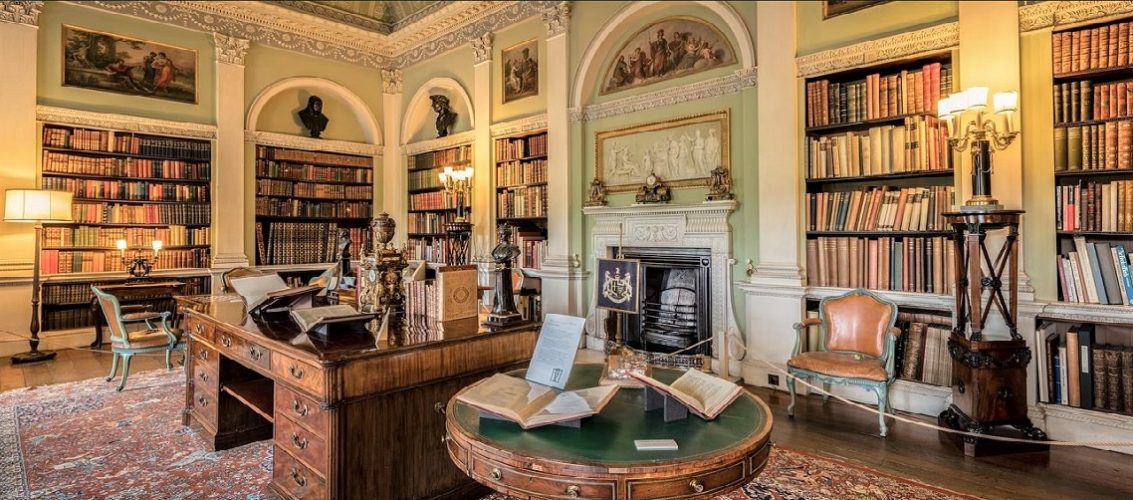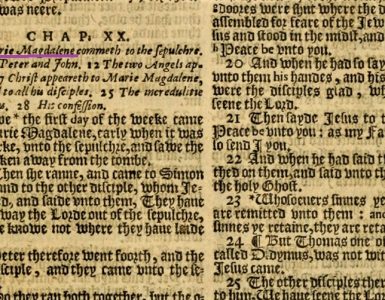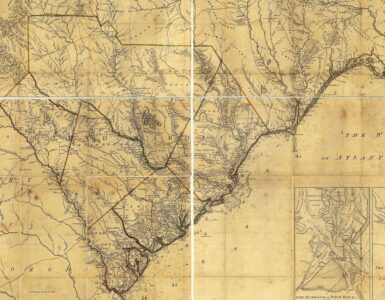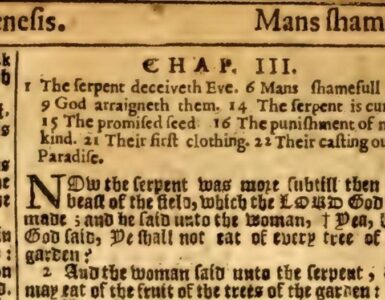The following is transcribed from, The New York Observer, Thursday, May 10, 1906, 591-92.
THE PRINCETON SEMINARY OF THE FUTURE
By an Interested Observcr.
ONE of the striking things about an institution with a continuous life is that it does not grow old. It may look back upon a long past, but every year is a new beginning. Upon each year lies the dew of youth, and from it the prospect broadens into the future. Princeton Seminary has completed almost a century of life, and this century has been filled with achievement. But its friends, as they look upon it, find themselves thinking less of the past than of the future. It does not present itself to their view as an old institution rounding out its hundred years of accomplished work. It presents itself as a young institution girding itself for a great work lying at its hand.
What lies in the remote future would be idle to speculate. But what lies immediately at our doors rightly attracts our thought. And there are some things which, it is safe to say, lie immediately in the future of Princeton Seminary, and these it may be not only pleasing but profitable to call to mind.
For one thing it is safe to say that Princeton Seminary will continue in the future, as in the past, with faithfulness and devotion to perform the service for which it was established, and in the performance of which it has prospered. This service is expressed with singular point and remarkable breadth on the foundation document of the Seminary, the “Plan,” which the General Assembly adopted in 1811 as the basis of the new venture it was making in providing for the training of ministers. Briefly, the Assembly desired the Seminary “to provide for the Church an adequate supply and succession of able and faithful ministers of the New Testament”; “to furnish the congregation with enlightened, humble, zealous, laborious pastors”; “to form men for the Gospel ministry, who shall truly believe and cordially live, and therefore endeavor to propagate and defend, in its genuineness, simplicity and fulness the faith of the Church, whether against unbelievers or misbelievers”; and “to found a nursery for missionaries to the heathen and to such as are destitute of the stated preaching of the Gospel.”
How Princeton Seminary has performed this service in the past its roll of 5,420 students, of whom 358 have devoted themselves to work in the foreign field, will testify. What encourages its friends most, as they look forward to the future of the Seminary, is that it is the spirit of these requirements which characterizes the whole life of the Seminary now. A foreign review of a recent publication emanating from the Seminary felt it enough to say of it, meaning it perhaps not altogether to its praise, “Princeton Seminary is excessively zealous for the Gospel.” The Gospel is a good thing to be “excessively zealous” for. An incident which occurred at the “Commencement” just past well attested the missionary interest which is diffused among the student body. The sad death of a young missionary [John Rogers Peale] in China, who had left the Seminary only last spring, has naturally deeply moved the Seminary during the past year; and the students of their own motion conceived and executed the plan to erect a bronze tablet in the building devoted to the classroom work of the institution, bearing the following inscription:
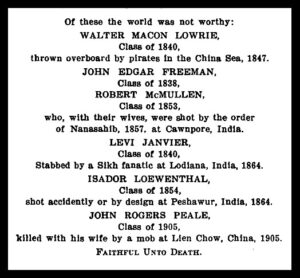
If the example of the devotion here commemorated presides over all the classroom exercises of the Seminary of the future, it is a bright future which is in store for it.
Another thing which it is safe to predict for the near future of Princeton Seminary is increased service to Christian culture and theological learning. This, too, will be merely a fuller realization of the design of the Assembly in founding the institution. Among the purposes to be subserved by the new institution, there are enumerated in the basal document or “Plan” these: “To unite in those who sustain the ministerial office, religion and literature”; “piety of the heart with solid learning”; “to afford more advantages than have hitherto been usually possessed”; to cultivate both piety and literature”; and “to provide for the Church men who shall be able to defend the faith.”
Among the instrumentalities which are now more fully to be utilized in the Seminary for the stimulation of study and the acquisition of sacred learning. the establishment of a number of additional fellowships is to be counted. Princeton Seminary has for a number of years had a single fellowship, conferred by competition, paying the successful candidate the sum of $600, and requiring of him an additional year’s devotion to a specified branch of theological learning. More lately two others have been established, and now three others still have been added. Hereafter there will be, therefore, six of these fellowships available. The amount of good they accomplish in the general stimulation of study in the Seminary it is difficult to estimate. But if we may judge their effect from the careers of the successful competitors in after life, they are sure to prove a great blessing to the Church. The single one of the fellowships which has been in operation long enough to provide some basis of judgment on this ground is the George S. Green Fellowship in Old Testament Literature. This fellowship was announced in 1879-80, and conferred for the first time at the close of the session 1880-1881. Twenty-three appointments have been made to it; the later four or five of which obviously have not yet had time to find their appropriate places in the Church. Of the rest, 13 are serving the Church in professorships and 5 on the foreign field.
The roll includes the names of Professor A. C. Zenos, of McCormick Seminary; Professor W. L. Pearson, of the Friends School (Penn College), Oscaloosa, Iowa; Professor Chalmers Martin, of Wooster University; Professor John D. David, of Princeton Seminary; Donald McLaren, for a number of years a missionary to Brazil; Professor G. Vos, of Princeton Seminary; Paul Martin, Registrar and Secretary of the Faculty, Princeton Seminary; Professor G. S. Duncan, formerly in Howard University, now of the High School, Berlin; Professor Edward Mack, of Lane Seminary; Professor Lewis B. Paton, of Hartford Seminary; Professor William A. Shedd, of Oroomiah, Persia [associate of Samuel G. Wilson]; Professor G. L. Johnstone, of Lincoln University; Professor K. D. MacMillan, of Princeton Seminary; and Professor James Oscar Boyd, of Princeton Seminary. The Alumni Fellowship in the New Testament, which has been in operation only a little over a decade, has already provided the Church with three professors, and one of the most esteemed of our evangelists, and has given our sister Episcopalian denomination one of its most admired teachers in Christian Archaeology. If the new fellowships give as good accounts of themselves as this, the Princeton Seminary of the future will be a perfect hive of learning.
Another marked feature of the new Princeton is what may without exaggeration be called the immense development of advanced theological instruction which finds a place in it. Advanced theological instruction has always been a feature in the work of the Seminary, and indeed it is already implied in its “Plan” that inspires it. But it is only of late years that it has come fully to its rights. Now the number of advanced classes offered each year in the institution equals those forming part of the regular curriculum work. By the successful establishment of this mass of advanced work the Seminary seems to have solved the problem of giving scope to individual predilection on the part of the students without injury to their complete and systematical preparation for their future work. In Princeton, students add to their full curriculum the branches of study they have a predilection for, instead of substituting them for the curriculum for any part of the curriculum. This to the advantage of their own depth and breadth of culture, and to the benefit of the churches they are to serve.
One of the results of this large development of extra curriculum teaching is the attraction to the Seminary of a large and ever-increasing number of “Graduate Students” pursuing advanced courses looking, now to the degree of Bachelor of Divinity, now merely to their own fuller theological culture. During the session 1904-5 thirty-four such students resorted to the Seminary; during that of 1905-6 thirty. About forty separate courses of study were offered to them. One of the incidental and perhaps unexpected benefits which has resulted from the presence in the Seminary of so large a body of mature men, many of them with some years of experience in the pastorate or in mission fields, has been a notable increase in the entire student body of enthusiasm for work, a sober interest in theological science and a sane and hopeful outlook upon the practical work lying before them. It is not so much an increase as a clearance of the academic atmosphere that has been produced; an increase of consecration and a wider and more mature way of regarding both the work in the Seminary and that greater work to which this work leads up.
We may confidently predict for the near future of the Seminary, then, both what we may call a heightening and a deepening of its work. We may also predict for it what we may call a broadening of its work. The large development of the extra curriculum work of the Seminary brings this about of itself. Many students take advantage of these extra curriculum studies to deepen their knowledge of this or that department of theological science. They thus, while losing no whit of their systematic preparation for discharging the office of the ministry, become specialists in this or the other department of theology, such as Apologetics, Old Testament Criticism, New Testament Literature, Church History or Dogmatics. Others, not wishing to specialize, may take advantage of the same opportunities to widen their theological outlook and broaden their theological culture. That such advantages may be open to all, as well as to serve other obvious ends, the classroom work is immediately to be so adjusted that the regular curriculum of studies may be compressed as heretofore into three years, or distributed over four. The students following the latter course will find abundant leisure on their hands for the widest theological culture outside of the curriculum.
Another result which comes from this readjustment of the classroom work, in connection with the rich development of extra curriculum work, is the possibility of making up courses in the Seminary suited to the needs of lay workers, prospective Bible teachers in our schools and colleges, missionary agents and the like, who do not have the ministry in view, but who would like to obtain a knowledge of the Bible and of the several branches of theology competent for their work. The Seminary does not exist, of course, to meet the needs of this class of students. It exists “to form men for the Gospel ministry.” But in doing the one it has perhaps unexpectedly opened the way to doing the other also. We may be sure it will not in the future despise this by product of its work. And we may confidently predict, therefore, that the next few years will witness a marked broadening of the work of the institution. It will reach the classes it is designed to reach better, and give them a fuller and more perfect preparation for their work. It will also reach more classes, and widen the area of its impact on the religious life of the times and of its supply of the religious needs of the day.
At all events, to one interested observer Princeton Theological Seminary seems now to stand but at the beginning of its way. And the motto it seems to take with it as it begins again that journey which it begins afresh each year, is, Heightening, Deepening, Broadening. We look for it to weave this motto year by year more and more ineffaceably into its history.
Princeton, N. J.
[Benjamin B.Warfield]
Notes–The header is “Harewood House Old Library Leeds UK,” from Wikimedia Commons, December 2, 2022. This article is transcribed from a PDF copy available from the Log College Press site at, “The Princeton Seminary of the Future (1906).” According to the Meeter and Nicole bibliography of B. B. Warfield’s publications there is a copy of the original article in his scrapbook with an annotation admitting his authorship.


